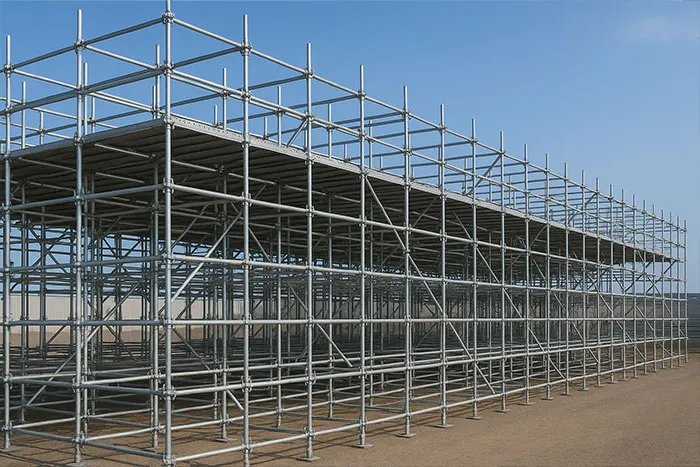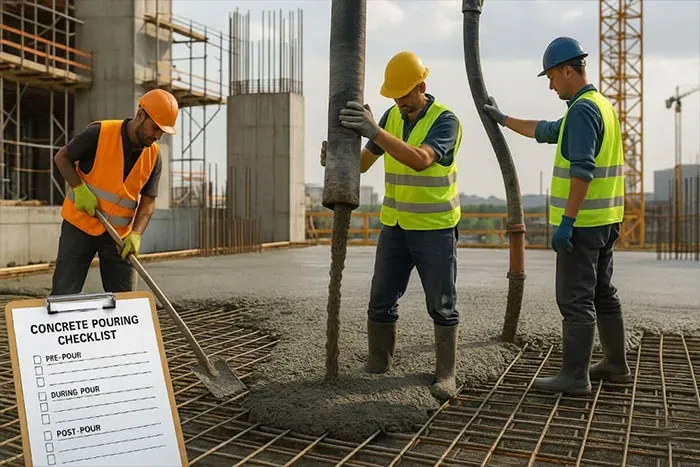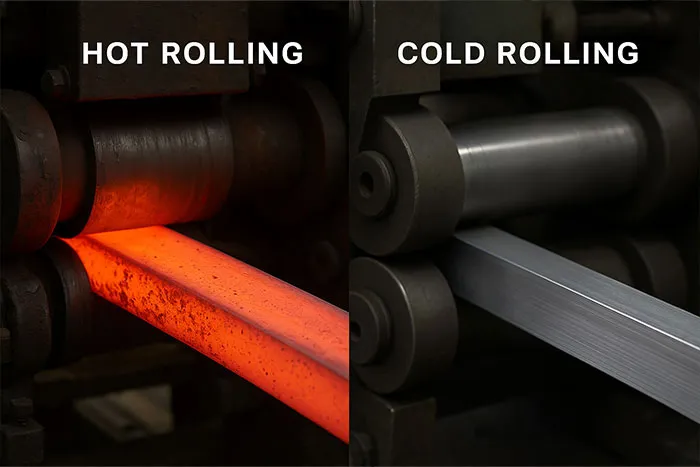
- Published:
- Written by: B.F.S Industries
What is the Best Scaffolding Systems Type?
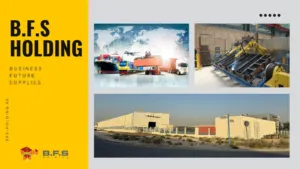
FREE DOWNLOAD – B.F.S. HOLDING
Explore the full spectrum of services and industries covered by B.F.S. Holding.
In the dynamic field of construction, where projects range from towering skyscrapers to intricate renovations, the question of “what is the best scaffolding systems type” frequently arises among professionals. The answer depends on project specifics, safety requirements, and efficiency goals—there is no one-size-fits-all solution. Scaffolding systems provide critical support for workers, materials, and equipment, ensuring safe access to elevated areas. Choosing the wrong scaffolding can result in costly delays, safety incidents, or regulatory non-compliance.
At BFS Industries, we specialize in providing high-quality scaffolding solutions tailored to diverse construction needs. From standard supported scaffolds to advanced modular systems, our solutions help professionals select the right scaffolding type for each project, balancing safety, efficiency, and cost-effectiveness. This article explores various scaffolding types—including supported, suspended, rolling/mobile, cantilever, frame, and system/modular scaffolding—offering technical insights, comparisons, and practical recommendations to guide construction professionals in making informed decisions.
Importance of Choosing the Right Scaffolding
Scaffolding is more than a temporary structure—it’s the backbone of safe and efficient construction work. With global construction output projected to grow significantly, the demand for reliable scaffolding systems has never been higher. Poor scaffolding choices can result in structural failures, worker injuries, or regulatory violations, costing projects dearly in time and money. Industry reports indicate that scaffolding-related incidents account for a notable portion of construction accidents, highlighting the need for careful selection.
Selecting the appropriate scaffolding type requires balancing factors such as stability, mobility, and adaptability to site conditions. Whether you’re working on a high-rise building or a residential repair, the right scaffolding enhances productivity while maintaining compliance with scaffolding safety standards. For a deeper understanding of how to select the most suitable scaffolding setup, check out our detailed guide on Choose the Right Scaffolding System. This guide explores key considerations, detailed comparisons of scaffolding types, material options, and actionable tips to help construction professionals determine what is the best scaffolding type for their projects.
Key Factors to Consider When Selecting Scaffolding
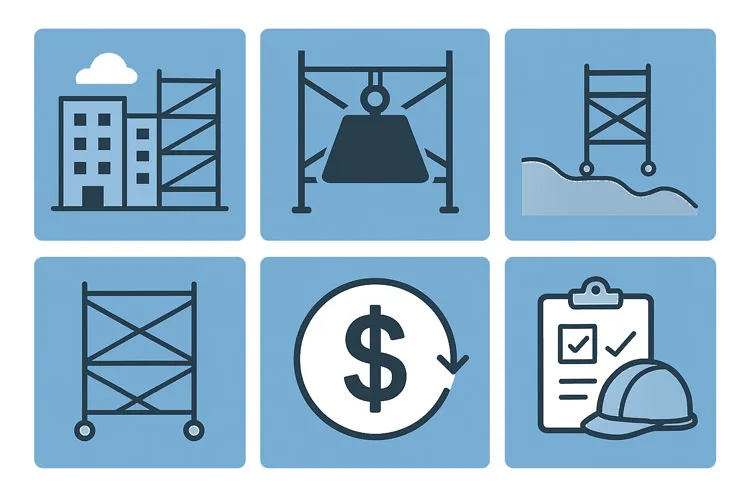
Before diving into specific types, it’s essential to evaluate several critical factors that influence your choice of Shoring and Scaffolding Systems. Proper evaluation ensures the selected system aligns with project requirements, safety standards, and regulatory compliance.
Project Scope and Height: For low-rise projects, supported or frame scaffolding may suffice, while high-altitude work often requires suspended or cantilever options.
Load Capacity: Consider the weight of workers, tools, and materials. Heavy-duty tasks demand robust systems, such as steel-supported scaffolding.
Site Conditions: Uneven terrain favors mobile scaffolding, whereas confined spaces may benefit from modular scaffolding due to its flexibility.
Mobility Needs: If frequent repositioning is required, rolling/mobile scaffolding minimizes downtime.
Budget and Timeline: Factor in initial costs, assembly time, and maintenance. Modular systems, although pricier upfront, provide long-term efficiency gains.
Safety and Regulations: Compliance with OSHA or international standards is essential, including fall protection measures and inspection protocols.
Environmental Factors: Projects exposed to harsh weather may require corrosion-resistant materials like aluminum.
By carefully assessing these factors, construction professionals can avoid common pitfalls such as overloading or instability and optimize the performance, safety, and efficiency of their Shoring and Scaffolding Systems.
Types of Scaffolding with Detailed Description, Advantages, Disadvantages
Understanding the diverse scaffolding types is essential to answering “what is the best scaffolding type.” Below, we detail the main categories: supported, suspended, rolling/mobile, cantilever, frame, and system/modular scaffolding. Each section provides technical descriptions, advantages, disadvantages, and real-world applications to help construction professionals make informed choices. For those working with modular systems, particularly cup-lock scaffolding, referring to a reliable Cup Lock Scaffolding Installation Manual ensures proper assembly, safety compliance, and optimal performance on-site.
Supported Scaffolding
Supported scaffolding, also known as ground-supported or fixed scaffolding, is constructed from the base upward using poles, frames, or uprights anchored securely to the ground. It is one of the most commonly used scaffolding types in construction, offering a stable platform across various heights. Technically, it comprises base plates, vertical standards, horizontal ledgers, and transoms, with platforms typically made from planks or boards. Load distribution is primarily vertical, relying on the ground’s bearing capacity, and often requires mud sills for soft or uneven surfaces.
Advantages:
Exceptional stability and load-bearing capacity, making it ideal for heavy-duty construction tasks.
Highly versatile, suitable for multiple project types, from building facades to bridges.
Cost-effective for long-term use due to the reusability of components.
Disadvantages:
Requires level ground; not suitable for uneven or sloped sites without adjustments.
Time-consuming to erect and dismantle, especially for large-scale setups.
Limited mobility, making it less efficient for projects requiring frequent repositioning.
In practice, supported scaffolding excels in new construction projects where a solid foundation is available. At BFS Industries, our supported scaffolding systems are designed for maximum stability, efficiency, and safety, helping construction teams complete multi-story office buildings and other projects with confidence.
Suspended Scaffolding
Suspended scaffolding is a type of scaffolding that hangs from the roof or an upper structure using ropes, wires, or chains, allowing workers to access high elevations without relying on ground support. Common types include two-point (swing stage), multi-point adjustable, and catenary systems. Technically, these scaffolds feature counterweights, outriggers, and winches for precise height adjustment, with platforms typically equipped with guardrails and toeboards to ensure worker safety.
Advantages:
Ideal for tall structures such as skyscrapers and bridges where ground access is limited or impractical.
Adjustable height provides flexibility during ongoing work.
Minimal ground footprint, reducing site disruption and allowing continued operations below.
Disadvantages:
Higher risk of swaying in windy conditions, requiring additional stabilization measures.
Limited load capacity compared to supported scaffolding.
Requires skilled operators for safe assembly, operation, and dismantling.
Suspended scaffolding is commonly used for tasks such as exterior painting, façade maintenance, or window washing on high-rise buildings. At BFS Industries, our suspended scaffolding systems are engineered for maximum safety, reliability, and ease of use, ensuring that construction teams can efficiently complete high-elevation projects without compromising safety or workflow.
Cantilever Scaffolding
Cantilever scaffolding extends horizontally from the building structure and is supported by needles or brackets anchored securely into the wall. This type is particularly useful when ground support is not feasible, such as over sidewalks, roads, or water. Technically, it involves needles projecting from the building, with platforms built outward, and strict load calculations must be followed to prevent cantilever failure.
Advantages:
Enables work over obstacles such as streets, rivers, or pedestrian areas.
Provides unobstructed access at ground level, minimizing site disruption.
Customizable for buildings with irregular shapes or architectural features.
Disadvantages:
Installation is complex and requires structural engineering input.
Higher risk of instability if not properly anchored.
Limited to specific applications and not as versatile for general construction use.
Cantilever scaffolding is commonly applied in projects such as cornice restoration on historic buildings or bridge undersides, where traditional ground-supported scaffolding is impractical. At BFS Industries, our cantilever scaffolding systems are designed for stability, safety, and adaptability, ensuring that construction teams can work efficiently in challenging or restricted areas.
Frame Scaffolding
Frame scaffolding, often referred to as H-frame or baker scaffolding, utilizes pre-fabricated frames connected by cross braces. While it is technically a subset of supported scaffolding, it stands out due to its modular frame design. These systems typically feature welded steel or aluminum frames, with platforms secured using pins or hooks, and standard bay widths of 1.5–2 meters.
Advantages:
Simple and fast assembly, reducing labor costs.
Economical solution for small to medium-sized projects.
Stackable frames allow flexible adjustment for varying heights.
Disadvantages:
Less adaptable for complex or irregular building shapes compared to modular systems.
Heavier components may complicate transport and handling.
Risk of misalignment if not properly braced during assembly.
Frame scaffolding is widely used in residential construction for tasks such as siding installation, providing a reliable and cost-effective solution. At BFS Industries, our frame scaffolding systems are designed for maximum efficiency, safety, and ease of use, ensuring construction teams can complete projects quickly without compromising quality or stability.
System/Modular Scaffolding
System or modular scaffolding utilizes standardized components, such as ringlock, cuplock, or kwikstage systems, enabling quick interlocking assembly. These scaffolds are highly adaptable, with rosettes or cups that allow multi-directional connections, supporting complex configurations and high load capacities, often exceeding 50 kN per standard.
Advantages:
Rapid erection and exceptional versatility for irregular or custom structures.
Enhanced safety through secure locking mechanisms.
Highly efficient for large-scale industrial projects, reducing downtime and labor costs.
Disadvantages:
Higher initial investment due to specialized components.
Requires trained personnel for correct assembly and safe operation.
Bulkier components require more storage space.
Modular scaffolding is ideal for industrial and commercial settings, such as oil refineries or large-scale construction sites, where custom configurations and high adaptability are essential. At BFS Industries, our modular scaffolding systems are engineered for safety, reliability, and efficiency, allowing construction teams to tackle complex projects with confidence and precision.
Comparison of Scaffolding Types
| Scaffolding Type | Description | Advantages | Disadvantages | Best For | Supported Ground |
|---|---|---|---|---|---|
| Ground-based | Vertical load distribution | High stability, heavy loads | Immobile, needs level ground | New builds, bridges | Yes |
| Suspended | Hung from above, adjustable | Minimal footprint, high access | Sway risk, limited loads | High-rises, maintenance | No |
| Rolling/Mobile | Wheeled base for movement | Quick repositioning, efficient | Tipping on uneven surfaces | Interiors, repairs | Yes |
| Cantilever | Protrudes from structure | Over obstacles, unobstructed below | Complex setup, instability risks | Cornices, over water | Partial |
| Frame | Pre-fab frames with braces | Easy assembly, cost-effective | Less flexible | Residential, small projects | Yes |
| System/Modular | Interlocking components | Versatile, fast erection | Higher cost, training needed | Industrial, complex shapes | Yes |
This comparison highlights that no single type is universally best; selection depends on project needs.
Safety Standards and Regulations
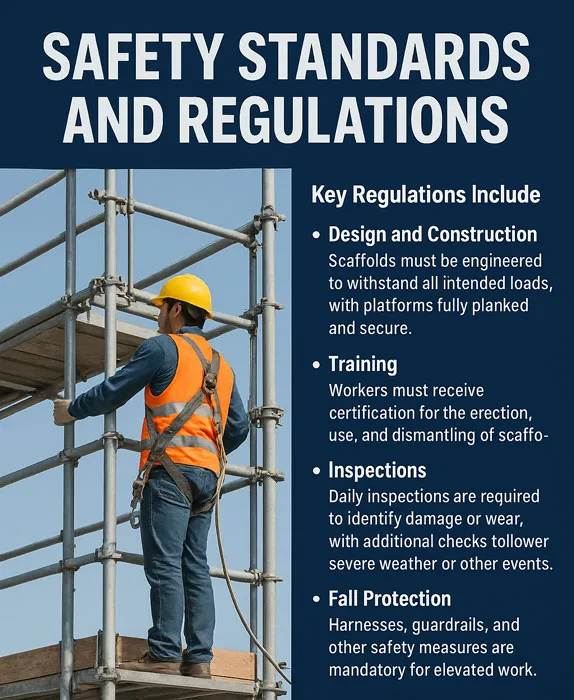
Scaffolding safety is a top priority in construction, strictly governed by standards such as OSHA 1926.451 in the United States, which mandates load capacities of at least four times the intended load, fall protection for heights above 10 feet, and inspections by competent personnel. Internationally, standards like ISO 9001 and EN 12811 provide similar guidelines, emphasizing the use of guardrails, toeboards, and proper access points to ensure worker safety.
Key Regulations Include:
Design and Construction: Scaffolds must be engineered to withstand all intended loads, with platforms fully planked and secure.
Training: Workers must receive certification for the erection, use, and dismantling of scaffolding.
Inspections: Daily inspections are required to identify damage or wear, with additional checks following severe weather or other events.
Fall Protection: Harnesses, guardrails, and other safety measures are mandatory for elevated work.
Failure to comply with these standards can result in fines, legal action, or project shutdowns. At BFS Industries, our scaffolding systems are designed to meet and exceed all relevant safety regulations, helping construction teams maintain compliance while protecting workers and optimizing project efficiency.
Material Considerations: Steel, Aluminum, Timber
The choice of scaffolding materials directly affects durability, weight, and overall cost. Steel is extremely robust and ideal for heavy-duty applications, though it can be prone to corrosion if not properly treated or galvanized. Aluminum is significantly lighter and highly resistant to corrosion, making it easy to handle on-site, but it generally comes at a higher cost. Timber, a traditional and economical option, provides good insulation but is susceptible to warping in damp conditions and has lower load-bearing capacity compared to metal alternatives.
Pros and Cons:
Steel: Pros – Strong and cost-effective; Cons – Heavy and prone to rust without protection.
Aluminum: Pros – Lightweight and durable; Cons – Higher cost and comparatively lower strength for extreme loads.
Timber: Pros – Eco-friendly and insulating; Cons – Degrades over time and has limited reuse potential.
Material selection should be guided by the project environment. Aluminum scaffolding is ideal for coastal or humid areas due to its corrosion resistance, while steel provides maximum strength for industrial applications. At BFS Industries, we offer scaffolding systems in steel, aluminum, and timber, ensuring the right material choice for every project while prioritizing safety, efficiency, and longevity.
Cost and Efficiency Analysis
Labor often represents the most significant portion of scaffolding project expenses, making efficient assembly a key factor in overall cost management. Modular scaffolding, such as Cuplock Scaffolding, offers rapid assembly and disassembly, which can substantially reduce labor time and project delays. Supported scaffolding types may have lower initial costs but are less efficient for complex or large-scale projects. Suspended systems, while requiring specialized equipment, can save time on ground preparation and site organization.
From an efficiency perspective, mobile scaffolding minimizes downtime during frequent repositioning, whereas system or modular scaffolding excels in large projects by offering adaptability and faster setup. By carefully evaluating project scale, complexity, and material choice, construction teams can achieve the best balance between cost, safety, and operational efficiency. At BFS Industries, our Cuplock and other modular scaffolding systems are engineered to maximize productivity while reducing total project costs and labor efforts.
Recommendations for Selecting the Best Scaffolding System Type
Determining the best scaffolding type depends largely on the specific requirements of the project. For high-rise construction, suspended or cantilever scaffolding provides efficient access to elevated work areas, while interior renovations benefit from mobile scaffolding due to its flexibility and ease of repositioning. Industrial facilities often require modular scaffolding for its adaptability to complex layouts, whereas residential builds typically rely on frame scaffolding for cost-effectiveness and simplicity.
Bridge work or projects over water may necessitate supported or cantilever scaffolding to ensure stability and safety. A practical approach is to conduct a thorough site survey and consult with engineers to identify the most suitable options. In cases where multiple needs arise, combining scaffolding types—such as mobile frames for adaptable access—can optimize efficiency and safety. At BFS Industries, our diverse scaffolding solutions are designed to meet these varied project demands, providing reliable, safe, and efficient systems for every construction scenario.
Maintenance and Inspection Tips
Regular maintenance is essential to extend the lifespan of scaffolding and ensure worker safety on construction sites. Daily inspections should be conducted to identify loose components, corrosion, or any structural damage. After use, scaffolding should be cleaned, stored in dry conditions, and moving parts lubricated to maintain smooth operation. Key practices include checking base plates and anchors for stability, ensuring platforms are level and securely fastened, and promptly replacing any damaged parts. For high-risk setups, professional audits should be scheduled regularly, and staff should be trained to recognize issues such as bent tubes or compromised structural elements. By adhering to these maintenance and inspection protocols, construction teams not only prevent accidents but also comply with safety regulations. At BFS Industries, our scaffolding systems are designed for durability and ease of maintenance, helping teams maintain peak performance while minimizing safety risks.
Conclusion
In conclusion, determining the best scaffolding type requires a careful balance between project requirements, safety, cost, and efficiency. Supported and frame scaffolding options provide reliable solutions for standard construction projects, while suspended and modular systems offer the flexibility needed for complex or challenging sites. Prioritizing scaffolding safety by adhering to OSHA and international standards, selecting materials thoughtfully—such as aluminum for lightweight and portable applications—and implementing a rigorous maintenance program are essential for successful outcomes. By evaluating critical factors, comparing scaffolding types, and consulting experts when needed, construction professionals can enhance project efficiency, reduce risks, and achieve superior results. At BFS Industries, our wide range of scaffolding solutions is designed to meet diverse project demands, ensuring safety, reliability, and optimal performance. Ultimately, the “best” scaffolding system is the one that aligns seamlessly with the unique needs of each project.
FAQs
1- What is the most common scaffolding type in construction?
Frame scaffolding is one of the most widely used types due to its simplicity, cost-effectiveness, and reliability, making it ideal for residential projects and small commercial builds. At BFS Industries, our frame scaffolding systems provide durable and easy-to-assemble solutions for these applications.
2- How do I ensure scaffolding safety on site?
Ensuring scaffolding safety involves following OSHA guidelines, conducting daily inspections, providing fall protection, and training workers on proper assembly and use. Using reliable scaffolding systems, such as those offered by BFS Industries, can further enhance safety and reduce the risk of accidents.
3- Is aluminum better than steel for mobile scaffolding?
Aluminum is preferred for mobility-focused projects because it is lightweight, corrosion-resistant, and easy to handle. Steel, however, remains suitable for heavy-duty applications requiring maximum strength. Choosing the right material depends on project needs and environment.
4- What are the cost differences between modular and supported scaffolding?
Modular scaffolding, including systems like Cuplock Scaffolding, may have higher initial costs but offer efficiency and speed that reduce long-term labor and operational expenses. Supported scaffolding is generally more budget-friendly for straightforward projects but may be less efficient for complex setups.
5- Can cantilever scaffolding be used for high-rise buildings?
Cantilever scaffolding can be used for specific sections, such as work over streets or obstacles, but suspended scaffolding is often preferred for full-height access on high-rise structures due to better stability and versatility.
